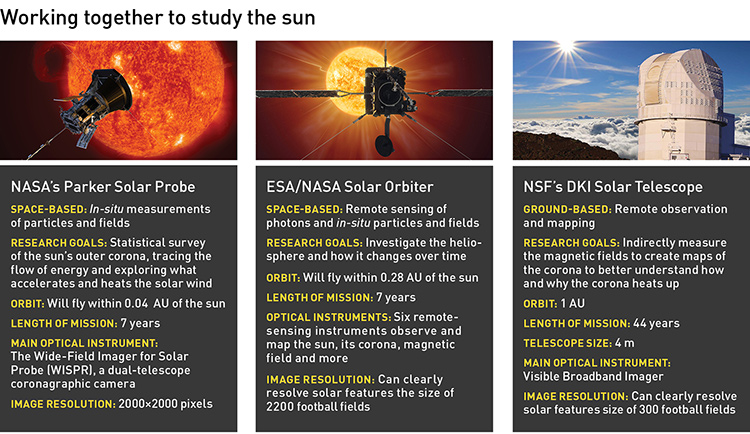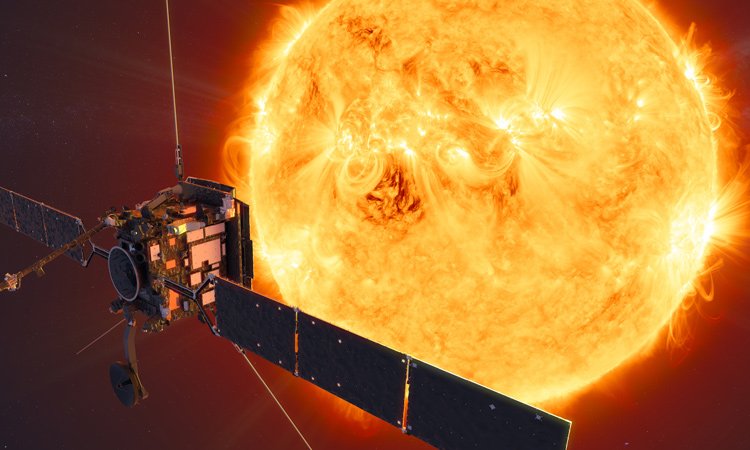 An artistic rendering of ESA’s Solar Orbiter. [ESA /ATG medialab]
An artistic rendering of ESA’s Solar Orbiter. [ESA /ATG medialab]
Until humans develop interstellar travel, the sun will remain the only star that appears larger than a dot in a telescope. Its violent mass ejections, twisty magnetic field lines and gradual temperature fluctuations create “space weather” events that light up the sky with auroras—and that can interfere with radio communications and electric-power grids. Yet even as the sun bathes the Earth in radiation and charged particles, it keeps many of its deepest secrets to itself.
Thanks to advances in adaptive optics, spacecraft technology and data science, three new observatories are embarking on a new round of dedicated solar studies.
Thanks to advances in adaptive optics, spacecraft technology and data science, three new observatories are embarking on a new round of dedicated solar studies. One space-based observing platform will approach closer to the sun—within 9 solar radii (6.26 million km) of its surface—than any human-made object. A second spacecraft, with collaborators from multiple nations, will get a unique view of the star’s north and south polar regions. Both spacecraft carry optical telescopes to capture close-up images of details in the photosphere and corona, as well as energetic-particle counters and magnetometers.
Though the third new observatory, the ground-based Daniel K. Inouye Solar Telescope (DKIST), is fixed on our home planet at a distance of 1 astronomical unit (AU; the Earth–sun distance, or 150 million km) from our central star, it employs the latest in adaptive optics to wipe away the turbulence in Earth’s atmosphere and perform high-resolution imaging and spectroscopy.
Of course, scientists have been pointing instruments toward the sun ever since the days of Galileo Galilei. Around the world, more than two dozen ground-based solar observatories target imagers, spectrographs and polarimeters sunward on every clear day. In space, both robotic satellites and crewed missions have carried instruments to study the heliosphere, photosphere and corona. Some missions have provided reliable data for decades; others were one-off experiments carried on crewed flights.
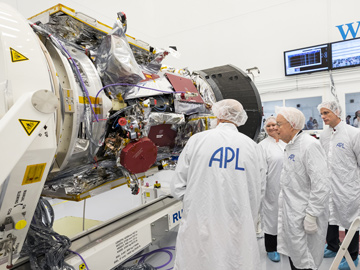 Eugene N. Parker (center) visits NASA’s Parker Solar Probe, the spacecraft that bears his name. [NASA/Johns Hopkins APL/Ed Whitman]
Eugene N. Parker (center) visits NASA’s Parker Solar Probe, the spacecraft that bears his name. [NASA/Johns Hopkins APL/Ed Whitman]
Parker Solar Probe: Skirting the sun
The Space Sciences Board of the U.S. National Academy of Sciences first called for a spacecraft that could fly inside Mercury’s orbit to scoop up solar particles back in 1958—less than a month after the founding of NASA. The space mission that became the Parker Solar Probe was announced, canceled, redesigned and re-funded over a 20-year period before settling into its final configuration about 10 years ago.
Originally called Solar Probe Plus, NASA’s Parker Solar Probe is the first U.S. space mission to bear the name of a living person: Eugene N. Parker, a University of Chicago, USA, physicist who in the mid-1950s developed a pioneering theoretical model of the solar wind. Between its August 2018 launch and its seventh anniversary in space, the spacecraft is edging itself incrementally closer to our star’s hot corona with every orbit.
“It turns out it is remarkably difficult to get close to the sun,” says Adam Szabo, NASA’s mission scientist for Parker. The Earth is already zipping around its star at an orbital speed of 27.8 km/s, so to fall toward the sun, the engines of the probe’s Delta IV Heavy launch vehicle needed to apply the brakes. That initial reverse boost set the spacecraft into a highly elliptical orbit that gets periodic gravitational nudges from the planet Venus. Thanks to Kepler’s laws of planetary motion, Parker slows its motion when coasting in the vicinity of Earth and Venus and accelerates like a whip in the dangerous zone closest to the sun.
To guard against the extreme incident radiation—at perihelion, or the point of closest approach, about 475 times as intense a dose as a satellite in Earth orbit receives—Parker has its Thermal Protection System: a hexagonal carbon–carbon composite shield, coated with reflective white alumina, on its sun-facing side. Four light sensors help the craft’s autonomous guidance system adjust its attitude to prevent radiation damage to the electronics. According to Szabo, the side facing away from the sun is always cold because the craft is radiating its thermal energy out into the vastness of space. Thus, the instruments need small heaters to protect them from the overwhelming chill.
During Parker’s fourth perihelion approach in late January 2020, when the probe was 18.6 million km from the sun, the solar-facing side of the heat shield reached an estimated 612 °C, while the instruments remained at a comfortable 30 °C. By 2025, perihelion temperatures on the sunward side of the shield may reach 1370 °C.
Johns Hopkins University’s Applied Physics Laboratory (APL), USA, built the Parker Solar Probe for NASA, and the principal investigators for its instruments represent seven other U.S. institutions. Parker is loaded with magnetometers, plasma voltage sensors, a mass spectrometer and a Faraday cup for counting charged particles in vacuum.
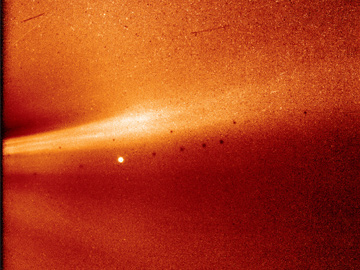 Image from Parker Solar Probe’s WISPR (Wide-field Imager for Solar Probe) instrument shows a coronal streamer, seen over the east limb of the sun. [NASA/NRL/Parker Solar Probe]
Image from Parker Solar Probe’s WISPR (Wide-field Imager for Solar Probe) instrument shows a coronal streamer, seen over the east limb of the sun. [NASA/NRL/Parker Solar Probe]
Seeing through WISPR
Parker’s main optical instrument, the Wide-Field Imager for Solar Probe (WISPR), is a dual-telescope coronagraphic camera that sits behind the heat shield. With baffles to block a direct view of the photosphere, WISPR looks sideways and captures images of the corona from 13 to 108 degrees from the sun. According to Szabo, it collects photons that are scattered by electrons within the solar wind.
WISPR was initially supposed to have only one telescope but was redesigned to fit around two external communications antennas, says Russell A. Howard of the U.S. Naval Research Laboratory, WISPR’s principal investigator. Each telescope has an active-pixel CMOS sensor designed to pick up light 13 to 15 orders of magnitude dimmer than a direct view of the sun at that distance.
Parker started contributing to science in November 2018, when the spacecraft made its first close approach to the sun at a radial distance of 0.28 AU. For example, during the first flyby, scientists investigated the shape of the so-called heliospheric current sheet (HCS) inside the orbit of Venus. The HCS is the boundary between north and south polarities of the sun’s magnetic field; although it’s called a sheet, it’s not flat, but a three-dimensional warped spiral extending through the solar system and having complex interactions with the solar wind. Parker’s data mostly agreed with magnetohydrodynamic models and observations from an earlier satellite mission, but showed some small-structure divergence from the latter.
Also during the first solar flyby, WISPR observed a coronal mass ejection (CME) moving approximately 200 to 300 km/s from its field of view. Scientists who studied the event, including Howard, characterized it as “typical of slow, streamer blowout CMEs.” The team was also able to compare the ejection’s structural details with those seen from the Solar and Heliospheric Observatory (SOHO), a spacecraft that has been stationed at a Lagrangian point 0.9 AU from the sun for nearly a quarter century.
At the perihelion of its sixth solar encounter, 27 September 2020, Parker flew within 13.5 million kilometers—a mere 0.09 AU—of the sun’s photosphere. According to APL’s Parker data gateway, as of 24 October 2020, the spacecraft was traveling more than 27 km/s at a distance of nearly 98 million km (0.65 AU) from the sun, just inside the orbit of Venus.
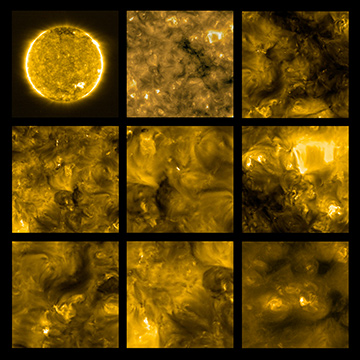 The Extreme Ultraviolet Imager (EUI) on ESA’s Solar Orbiter spacecraft took full-disc images (top left) using the Full Sun Imager (FSI) telescope, as well as high-resolution images using the HRIEUV telescope in May 2020. They show the sun’s appearance at a wavelength of 17 nm, revealing features as small as 400 km across. [Solar Orbiter/EUI Team/ESA & NASA; CSL, IAS, MPS, PMOD/WRC, ROB, UCL/MSSL]
The Extreme Ultraviolet Imager (EUI) on ESA’s Solar Orbiter spacecraft took full-disc images (top left) using the Full Sun Imager (FSI) telescope, as well as high-resolution images using the HRIEUV telescope in May 2020. They show the sun’s appearance at a wavelength of 17 nm, revealing features as small as 400 km across. [Solar Orbiter/EUI Team/ESA & NASA; CSL, IAS, MPS, PMOD/WRC, ROB, UCL/MSSL]
Solar Orbiter: Checking the poles
Solar Orbiter, developed by the European Space Agency (ESA) with NASA’s collaboration, has been an international project from the start. NASA provided one entire instrument, the Solar Orbiter Heliospheric Imager (SoloHI); hardware and sensors for three other instruments; and the launch rocket.
Solar Orbiter’s stated mission is to investigate the heliosphere and how it changes over time. Solar Orbiter won’t approach the sun as closely as Parker, but it will still get gravity assists from the inner planets to swoop as close as 0.28 AU, which is inside the orbit of Mercury.
The spacecraft will bring an ultraviolet imaging instrument nearer to the sun than any previous UV camera, says Teresa Nieves-Chinchilla, a solar physicist at NASA Goddard Space Flight Center, USA, and the project scientist for NASA’s part of the mission collaboration.
At these high “heliographic latitudes,” Solar Orbiter will make the first detailed surface magnetic maps of the sun’s polar regions.
Not only are those slingshot maneuvers speeding up Solar Orbiter, but over time, they will lift the spacecraft as high as 33 degrees out of the ecliptic plane in which Earth and most other major and minor planets revolve around the sun. At these high “heliographic latitudes,” which Solar Orbiter won’t reach until the late 2020s, the craft will make the first detailed surface magnetic maps of the sun’s polar regions. Scientists know that the solar magnetic field changes dramatically over the course of its 11-year cycle, but they do not know what part of the sun drives its dynamo.
Eventually, Solar Orbiter will approach the sun as close as 0.28 AU, more distant than Parker’s deep dives, but still respectably within Mercury’s eccentric orbit. In that middle distance between Parker and DKIST, Solar Orbiter is probing the inner heliosphere for energetic particles and magnetic field activity.
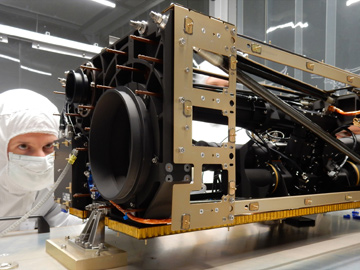 The Polarimetric and Helioseismic Imager instrument (PHI) is one of six imaging instruments on Solar Orbiter, providing high-resolution measurements of the magnetic field across the photosphere and mapping its brightness at visible wavelengths. [Max Planck Institute for Solar System Research]
The Polarimetric and Helioseismic Imager instrument (PHI) is one of six imaging instruments on Solar Orbiter, providing high-resolution measurements of the magnetic field across the photosphere and mapping its brightness at visible wavelengths. [Max Planck Institute for Solar System Research]
Detectors and sensors
ESA, which primarily manages the mission, selected six remote-sensing instruments and four in situ detectors to ride aboard Solar Orbiter. Among the remote sensors, the Extreme Ultraviolet Imager (EUI), developed at the Royal Observatory of Belgium, took the spacecraft’s “first light” images at a distance of 77 million km from the sun’s surface. The images revealed never-before-seen small, bright features immediately dubbed “campfires,” although scientists are still trying to determine whether they are miniature solar flares or another phenomenon entirely.
The basic technology of SoloHI improves upon the design of earlier space-based coronagraphs, says Howard, who also serves as SoloHI’s principal investigator. SoloHI rejects solar-disk light to see the faint coronal signal with a favorable signal-to-noise ratio, like the white-light coronagraphs launched aboard a pair of NASA spacecraft called STEREO, for Solar Terrestrial Relations Observatory. With a 40-degree-square field of view—double that of the STEREO coronagraphs—SoloHI’s 3968×3968-pixel detector collects photons from 500 nm to 850 nm wavelength. The new instrument uses a CMOS detector instead of the previous generation’s CCD detector for less power consumption. Four sets of baffles restrict stray light from entering the instrument.
Since their initial commissioning and the publicity surrounding Solar Orbiter’s “first light” images, most of the remote-sensing instruments are resting in “cruise phase”—turned off until the official start of the scientific mission in November 2021, according to Nieves-Chinchilla. Because the spacecraft launched from Earth on 10 February 2020, just as the coronavirus pandemic was hitting Europe, scientists had to work around public health restrictions to finish their initial instrument calibrations, but without long-term effects on the mission.
Besides SoloHI and EUI, these instruments include Metis, a visible-UV coronagraph from the University of Florence, Italy; the Polarimetric and Helioseismic Imager (PHI), for studying the photosphere’s magnetic field, from the Max Planck Institute for Solar System Research, Germany; Spectral Imaging of the Coronal Environment (SPICE), an extreme-UV spectrograph from the Institut d’Astrophysique Spatiale, France; and STIX, the X-ray Spectrometer/Telescope from the University of Applied Sciences of Northwest Switzerland.
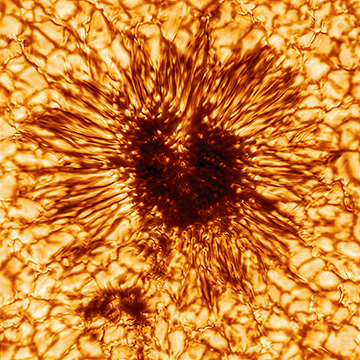 DKIST’s first image of a sunspot revealed the details of the sunspot’s structure as seen at the sun’s surface. The sunspot is sculpted by a convergence of intense magnetic fields and hot gas boiling up from below. [National Solar Observatory/AURA/National Science Foundation]
DKIST’s first image of a sunspot revealed the details of the sunspot’s structure as seen at the sun’s surface. The sunspot is sculpted by a convergence of intense magnetic fields and hot gas boiling up from below. [National Solar Observatory/AURA/National Science Foundation]
DKIST: On-the-ground adaptive optics
High above the Pacific Ocean, atop the Maui mountain Haleakala in Hawaii, USA, sits the brand-new DKIST, the world’s largest dedicated solar telescope when it saw its first light in December 2019. Its 3050-m elevation brings the observatory a mere 0.002% closer to the sun than the surrounding ocean, but the site provides the telescope with crisp skies favorable for coronal observing.
Plans for a 4-m-class solar telescope began with general studies in the mid-1990s, according to DKIST director Thomas Rimmele of the National Solar Observatory, USA. The project originally was called the Advanced Technology Solar Telescope, but during construction it was renamed to honor Inouye, a World War II hero and longtime U.S. senator from Hawaii, who died in 2012.
With a 13-story dome enclosing a 4-m-aperture telescope, the DKIST building resembles any of the other similarly sized professional observatories that scan the night sky. Inside, the off-axis telescope sits above a control room housing the imaging and spectroscopic instruments that receive and process the telescope’s raw images, plus computers for telescope control, data processing and storage.
However, the telescope and observatory building have several key differences that make DKIST different from both its nighttime cousins and many other solar telescopes: new adaptive optics, a thermal management system and the expectation of giant data sets.
To correct for seeing distortion under a dark sky, an astronomical telescope’s adaptive-optics system tracks either a bright natural star or a laser “guide star” and measures the shape of the incoming wavefront. Then the system removes the distortion from a relatively narrow field of view, perhaps 10 arcseconds (arcsec).
The sun, however, is what astronomers call an “extended source,” much wider than a point source of light. The star’s angular diameter, as seen from Earth, is roughly 31 arcminutes, or 0.5 degree, and physicists would like to remove the aberrations from as much of that field of view as possible. According to Rimmele, the only solar features with sharp edges that an adaptive-optics system could latch onto are the photosphere’s granules: the convection patterns of rising and falling plasma that make the solar surface look like a bowl of kernel corn. These features change over timescales of five to 10 minutes, so scientists want to capture as many of them in a single image as they can.
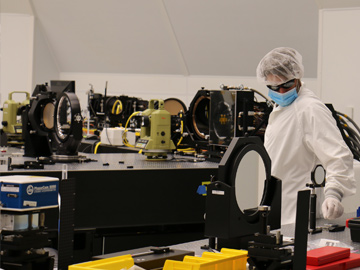 A scientist works inside DKIST’s Coudé lab. The physics lab, which weighs 150 tons, rotates to position five scientific cameras as the telescope tracks the sun across the sky. Mirrors, beam splitters and filters split the light so each camera receives a beam. [NSO/NSF/AURA]
A scientist works inside DKIST’s Coudé lab. The physics lab, which weighs 150 tons, rotates to position five scientific cameras as the telescope tracks the sun across the sky. Mirrors, beam splitters and filters split the light so each camera receives a beam. [NSO/NSF/AURA]
In with the new
Although DKIST is starting out with a conventional adaptive-optics system with a narrow field of view, in a few years it will upgrade to a newer technique known as multi-conjugate adaptive optics (MCAO). Originally tested at Big Bear Solar Observatory, USA, and NSO’s Richard B. Dunn Solar Telescope in New Mexico, USA, the MCAO system at DKIST will have three deformable mirrors and nine correlating Shack-Hartmann wavefront sensors to correct images across a maximum 60-arcsec field of view—more than enough to take in the whole face of the sun in one image.
The 0.76-m-aperture Dunn scope has a “vacuum tower” design, meaning that air is kept out of its interior light path. The primary mirror absorbs 5% to 10% of the energy hitting it and radiates it back out as heat. Above a hot surface, air generates turbulence—the enemy of any high-resolution observation. “If you put optics in a vacuum, there’s no air to heat up,” Rimmele says. However, “With a 4-m telescope, it’s really not practical to put it in a vacuum.”
A different approach—the one NSO chose for DKIST—is to keep all surfaces, including the primary mirror, at the ambient temperature of the environment to lessen the amount of turbulence that the adaptive optics must nullify.
The complex thermal control system includes wind gates to provide airflow to the enclosure and a heat stop to reject the excess solar-disk energy. The facility has 7.5 miles of pipe running through it; according to Rimmele, machines make a swimming pool’s worth of ice every night to cool the optics and other structures during the day.
For nighttime observations of faint stars and galaxies, telescopic aperture is almost everything; astronomers need the largest possible “bucket” to capture a tiny trickle of photons. So why do solar physicists, who are staring at the brightest light source from Earth’s perspective, need a 4-m aperture on their dedicated telescope? Actually, for many of its scientific studies, such as diffraction-limited measurements of the magnetic field of the sun’s extremely dim corona, the telescope is “photon-starved,” Rimmele says.
DKIST has several key differences from its nighttime cousins and many other solar telescopes: new adaptive optics, a thermal management system and the expectation of giant data sets.
Another way in which DKIST borrows from the 51-year-old Dunn telescope is a rotational design. The vertically fixed Dunn rotates on a unique bearing made of liquid mercury. DKIST itself doesn’t rotate, but the lower level of the observatory building, which contains the telescope’s instruments, rotates around to align with the scope’s light path depending on an observing team’s particular needs.
The Visible Broadband Imager (VBI) was designed to give detailed visible-light images through narrowband filters right up to the telescope’s diffraction limit, says its principal investigator Friedrich Wöger of the NSO. Its blue channel, with a 45-degree field of view, has filters ranging from the 393-nm spectral line of ionized calcium to the greenish-blue 486-nm H-β spectral line in hydrogen’s Balmer series. Its red channel, with a 69-degree field of view, is optimized for wavelengths starting with the famous 656.3-nm H-α line into the near infrared at 789 nm.
All of DKIST’s instruments will generate data at prodigious rates. For example, the VBI will gather about 1 GB per second, according to Rimmele. NSO has set up a data pipeline that employs real-time image reconstruction to combine as many as 80 camera frames into one high-resolution image that will be preserved. The system will discard the raw images after processing them—but even with that kind of compression, the observatory will generate roughly 3 petabytes (PB) of data annually.
The future of solar observing
NSO officials expect DKIST’s working life to last at least through two solar cycles, or the next 22 years. Parker’s mission is planned to last until 2025, but NASA has a track record of extending the useful lives of its spacecraft well beyond their original decommissioning dates. (The NASA–ESA Ulysses mission, whose heliocentric path outside Earth’s orbit allowed it to fly by Jupiter and several comets as well as gain a distant view of the solar poles, lasted 18 years until it was decommissioned in 2009.) Solar Orbiter will take most of this decade to reach a high orbital inclination for a spectacular view of the sun’s poles.
Several scientific organizations around the world have plans to develop new solar observatories over the coming decade. The Indian Space Research Organisation (ISRO) is scheduled to launch India’s first solar mission, Aditya (the Sanskrit word for “sun”), in January 2022. Meanwhile, China recently built a 1.8-m-aperture solar telescope and is reportedly planning an 8-m “ring” telescope dedicated to sun observations.
Since ancient people discovered the reflections of sunlight off water, solar physics and optical technology have been intertwined. Clearly, in the modern optical era, we can look forward to many more years of revealed secrets from—and jaw-dropping views of—our nearest star.
Patricia Daukantas is a freelance science writer based in Greenbelt, Maryland, USA.
To read more about DKIST’s Visible Tunable Filter and for references and resources, go online: www.osa-opn.org/link/eyes-on-the-sun.

